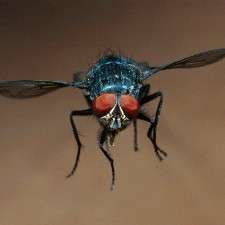Fly neurons could reveal the root of Alzheimer's disease

(Medical Xpress)—Although they're a common nuisance in the home, fruit flies have made great contributions to research in genetics and developmental biology. Now a Tel Aviv University researcher is again turning to this everyday pest to answer crucial questions about how neurons function at a cellular level—which may uncover the secrets of neurological disorders such as Alzheimer's disease.
Approximately 75 percent of the genes that are related to diseases in humans are also to be found in the fly, says Ya'ara Saad, a PhD candidate in the lab of Prof. Amir Ayali at TAU's Department of Zoology and the Sagol School of Neurosciences. There are many similarities in the functioning of the nervous system in both organisms, and by observing how neuronal networks taken from the fly grow and function outside of the body, there are many clues to the way human neuronal cells interact and the factors that influence their viability and physiology.
Saad's work, which has been published in the Journal of Molecular Histology, could help researchers to better understand how individual neurons are physically and chemically altered in response to disease and therapeutic intervention, and lead to new treatments.
Testing medications cell by cell
Saad is exploring how neural networks develop one neuron at a time. In the lab, the researchers break the fly's nervous system down into single cells, separate these cells, then place them at a distance from each other in a Petri dish. After a few days, the neurons begin to grow towards one another and establish connections, and then migrate to form clusters of cells. Finally, they re-organize themselves to form a sophisticated network, says Saad. Because these experiments uniquely allow researchers to concentrate on individual neurons, they can perform specific measurements of proteins, note electrical activity, watch synapses develop, and see how physical changes take shape.
Saad and her fellow researchers are using this technique to observe how neurodegenerative diseases take over the neurons and to potentially test various medicinal interventions. In their experiments, one group of flies is genetically modified so that it expresses a peptide called Amyloid Beta, found in protein-based plaques of human Alzheimer's disease patients. The results of these studies are then compared to those of a non-modified control group. Both strains of flies are provided by Prof. Daniel Segal of TAU's Department of Molecular Microbiology and Biotechnology.
Previous studies performed on flies expressing Amyloid Beta showed that they demonstrate Alzheimer's-like symptoms such as motor problems, impaired learning capabilities, and shorter lifespans. While this peptide has been researched for quite some time, scientists still do not know how it functions. Saad says her work may help unlock the mystery of this function. "Now I can really get into the molecular operation of Amyloid Beta inside the cell. I can watch the dysfunction in the synapses, monitor the proteins involved, and record electrical activity in a much more accessible way," she says.
Testing pharmacological agents is as simple as putting the medication into the dish and following how the cells change in response, Saad explains. Her next step will be to test various medications and search for a treatment that restores normal function, morphology, and chemical make-up to the neurons.
The benefits of invertebrates
As one of the first organisms for which scientists cracked the entire genome, there is a wealth of genetic information about the fruit fly, making it an ideal subject for her research, explains Saad. Though fly brains are simpler than those of human brains, the neurons are the same size and structure, and possess similar chemical activity. With a life span of 30 days on average, flies have a short aging process, an important consideration for the study of neurodegenerative diseases.
"A lot of basic discoveries in neurobiology have been made on invertebrates. If you want to see things on a cellular level, there are a lot of advantages to using these models," says Saad. She also says that using insects instead of mammals as experimental subjects has an additional plus: no ethical approval is necessary until the research is advanced enough to move on to more sophisticated life forms.
















